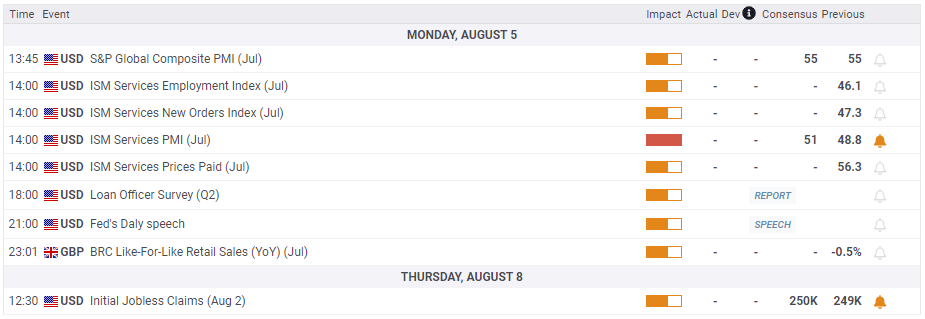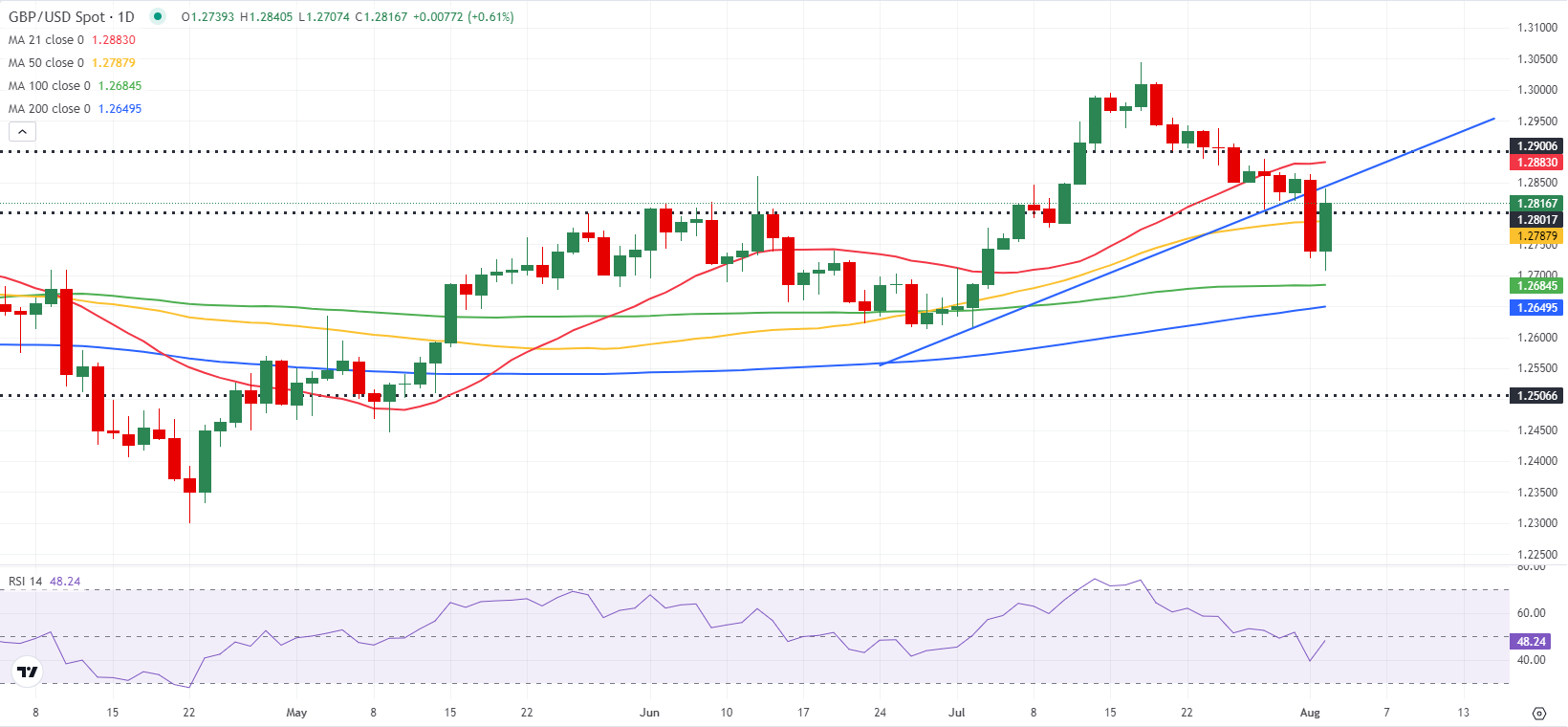- The Pound Sterling hit monthly lows near 1.2700 against the US Dollar.
- GBP/USD sellers set to retain control in the data-light week ahead.
- Defending the 200-day SMA at 1.2650 is critical for Pound Sterling amid a bearish RSI.
Recording a third consecutive weekly decline, the Pound Sterling (GBP) reached its lowest level in a month against the US Dollar (USD), leaving GBP/USD to battle the 1.2700 threshold.
Risk-aversion offset cautious BoE
GBP/USD remained at the losing end, despite the persistent divergent monetary policy outlooks between the US Federal Reserve (Fed) and the Bank of England (BoE), as the pair witnessed more of a risk trade rather than a rate trade.
Traders remained unnerved at the beginning of the week, anticipating a bunch of top-tier US economic data and central banks’ policy decisions later in the week. Their anxiety was heightened by the fresh escalation of the Middle East geopolitical tensions, between Israel and Iran.
Hamas reported on Tuesday the assassination of its political leader Ismail Haniyeh in an overnight strike in the Iranian capital Tehran. The Iran-backed militant group accused Israel of targeting Haniyeh. Subsequently, the New York Times reported that Iranian Supreme Leader Ali Khamenei had ordered a direct strike on Israel for the killing of Hamas chief Haniyeh. Meanwhile, Israel confirmed on Thursday the killing of Hamas military chief Mohammed Deif after days of suspense.
A heavy sell-off in global stocks, amid renewed US economic concerns, also played its part in fuelling a flight to safety mode, which helped revive the US Dollar (USD) demand as a safe haven. Meanwhile, traders washed their hands off risky assets such as the Pound Sterling.
The US ISM Manufacturing PMI showed further contraction and raised worries over the health of the economy. US ISM Manufacturing PMI declined from 48.5 to 46.8 in July, falling below the expected 48.8. New orders dropped from 49.3 to 47.4. Downbeat US data ramped up bets for a 50 bps September Fed rate cut to 31%, compared to 12% seen a day before.
Speaking of central banks, both the Fed and the BoE announced their interest-rate decisions during the week. The US central bank kept the fed funds rate at 5.25% to 5.5% but tweaked its policy statement to say that it is "attentive to the risks to both sides of its dual mandate", rather than previously only noting its attention to inflation risks.
During the press conference, Fed Chairman Jerome Powell said that “the broad sense of the committee is that the economy is moving closer to the point at which it would be appropriate to reduce our policy rate,” confirming a September rate cut.
On the other side, the BoE cut the key policy rate by 25 bps to 5.0%, with policymakers voting 5-4 in favor of the reduction. However, BoE Governor Andrew Bailey said the BoE's Monetary Policy Committee (MPC) would move cautiously going forward. "We need to make sure inflation stays low, and be careful not to cut interest rates too quickly or by too much," he said at the post-policy meeting press conference.
This divergence in the policy outlooks between the Fed and the BoE failed to offer any boost to the Pound Sterling, as risk aversion remained the underlying dominant theme heading into the US Nonfarm Payrolls (NFP) showdown on Friday.
The US Bureau of Labor Statistics (BLS) reported that NFP rose by 144,000 in July. This reading missed the market expectation of 175,000 by a wide margin. Additionally, the BLS announced that it revised the June increase of 206,000 lower to 179,000. Other details of the jobs report showed that the Unemployment Rate edged higher to 4.3% from 4.1% in June, while the Average Hourly Earnings increased by 3.6% on a yearly basis, compared to analysts’ estimate of 3.7%. The USD came under heavy selling pressure with the immediate reaction and allowed GBP/USD to erase a large portion of its weekly losses.
Week ahead: US ISM Services PMI and Fedspeak in focus
It’s a relatively quiet economic calendar in the week ahead, as Pound Sterling traders take a breather after two consecutive action-packed weeks.
There are no top-tier data releases from the UK, and therefore, the focus is expected to be solely on the US macro news and Fedspeak, as Fed policymakers return to the rostrum following the ‘blackout period’.
The US ISM Services PMI will stand out on Monday, as the final S&P Global Services PMI reports will be also published that day from the UK and the US.
There is nothing much of note on Tuesday and Wednesday but the BoE’s Quarterly Bulletin and the US Jobless Claims data will entertain traders on Thursday.
Friday will feature the Chinese inflation data, which could have a strong bearing on risk sentiment, impacting the value of the higher-yielding British Pound. Besides, the UK and the US docket are data-dry on the final trading day of the week.
GBP/USD: Technical Outlook
Following the downside break of the rising trendline support, then at 1.2835, the bearish potential for GBP/USD remains intact and could extend in the upcoming week.
The 14-day Relative Strength Index (RSI) stays below the 50 level, currently near 47.00, suggesting that the downside has more scope, while lacking bearish momentum.
That said, the immediate support for the Pound Sterling aligns at the 100-day Simple Moving Average (SMA) at 1.2683. If sellers crack that level, a test of the 200-day SMA at 1.2650 will be inevitable.
A daily closing below the critical 200-day SMA will likely trigger a fresh downtrend, with the next relevant support levels at the June low of 1.2613 and the mid-May low at around 1.2510.
On the flip side, any recovery in the pair is seen sustaining only if it manages to stabilize above the 1.2790-1.2800 supply zone, where the 50-day SMA and previous static resistance converge.
Further up, the rising trendline support-turned-resistance, now at 1.2850, could challenge the bearish commitments.
If the recovery momentum gathers traction, Pound Sterling buyers must recapture the confluence of the 21-day SMA and the March 8 high near 1.2890.
BoE FAQs
The Bank of England (BoE) decides monetary policy for the United Kingdom. Its primary goal is to achieve ‘price stability’, or a steady inflation rate of 2%. Its tool for achieving this is via the adjustment of base lending rates. The BoE sets the rate at which it lends to commercial banks and banks lend to each other, determining the level of interest rates in the economy overall. This also impacts the value of the Pound Sterling (GBP).
When inflation is above the Bank of England’s target it responds by raising interest rates, making it more expensive for people and businesses to access credit. This is positive for the Pound Sterling because higher interest rates make the UK a more attractive place for global investors to park their money. When inflation falls below target, it is a sign economic growth is slowing, and the BoE will consider lowering interest rates to cheapen credit in the hope businesses will borrow to invest in growth-generating projects – a negative for the Pound Sterling.
In extreme situations, the Bank of England can enact a policy called Quantitative Easing (QE). QE is the process by which the BoE substantially increases the flow of credit in a stuck financial system. QE is a last resort policy when lowering interest rates will not achieve the necessary result. The process of QE involves the BoE printing money to buy assets – usually government or AAA-rated corporate bonds – from banks and other financial institutions. QE usually results in a weaker Pound Sterling.
Quantitative tightening (QT) is the reverse of QE, enacted when the economy is strengthening and inflation starts rising. Whilst in QE the Bank of England (BoE) purchases government and corporate bonds from financial institutions to encourage them to lend; in QT, the BoE stops buying more bonds, and stops reinvesting the principal maturing on the bonds it already holds. It is usually positive for the Pound Sterling.
Information on these pages contains forward-looking statements that involve risks and uncertainties. Markets and instruments profiled on this page are for informational purposes only and should not in any way come across as a recommendation to buy or sell in these assets. You should do your own thorough research before making any investment decisions. FXStreet does not in any way guarantee that this information is free from mistakes, errors, or material misstatements. It also does not guarantee that this information is of a timely nature. Investing in Open Markets involves a great deal of risk, including the loss of all or a portion of your investment, as well as emotional distress. All risks, losses and costs associated with investing, including total loss of principal, are your responsibility. The views and opinions expressed in this article are those of the authors and do not necessarily reflect the official policy or position of FXStreet nor its advertisers. The author will not be held responsible for information that is found at the end of links posted on this page.
If not otherwise explicitly mentioned in the body of the article, at the time of writing, the author has no position in any stock mentioned in this article and no business relationship with any company mentioned. The author has not received compensation for writing this article, other than from FXStreet.
FXStreet and the author do not provide personalized recommendations. The author makes no representations as to the accuracy, completeness, or suitability of this information. FXStreet and the author will not be liable for any errors, omissions or any losses, injuries or damages arising from this information and its display or use. Errors and omissions excepted.
The author and FXStreet are not registered investment advisors and nothing in this article is intended to be investment advice.
Recommended Content
Editors’ Picks

EUR/USD extends recovery beyond 1.0400 amid Wall Street's turnaround
EUR/USD extends its recovery beyond 1.0400, helped by the better performance of Wall Street and softer-than-anticipated United States PCE inflation. Profit-taking ahead of the winter holidays also takes its toll.

GBP/USD nears 1.2600 on renewed USD weakness
GBP/USD extends its rebound from multi-month lows and approaches 1.2600. The US Dollar stays on the back foot after softer-than-expected PCE inflation data, helping the pair edge higher. Nevertheless, GBP/USD remains on track to end the week in negative territory.

Gold rises above $2,620 as US yields edge lower
Gold extends its daily rebound and trades above $2,620 on Friday. The benchmark 10-year US Treasury bond yield declines toward 4.5% following the PCE inflation data for November, helping XAU/USD stretch higher in the American session.

Bitcoin crashes to $96,000, altcoins bleed: Top trades for sidelined buyers
Bitcoin (BTC) slipped under the $100,000 milestone and touched the $96,000 level briefly on Friday, a sharp decline that has also hit hard prices of other altcoins and particularly meme coins.

Bank of England stays on hold, but a dovish front is building
Bank of England rates were maintained at 4.75% today, in line with expectations. However, the 6-3 vote split sent a moderately dovish signal to markets, prompting some dovish repricing and a weaker pound. We remain more dovish than market pricing for 2025.

Best Forex Brokers with Low Spreads
VERIFIED Low spreads are crucial for reducing trading costs. Explore top Forex brokers offering competitive spreads and high leverage. Compare options for EUR/USD, GBP/USD, USD/JPY, and Gold.

